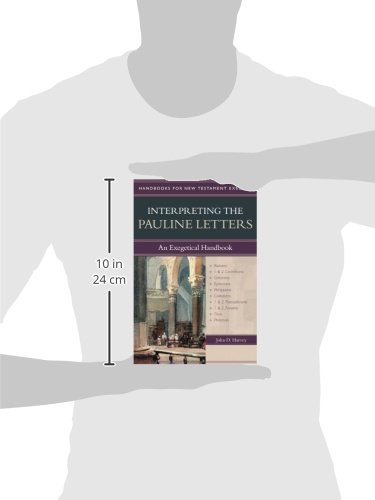


Full description not available
G**L
Helpful for theological studies
I use it for my theological studies and it's helpful
D**H
Fantastic Resource for Pastors!
I like things that save space. I love my Iphone because I can have all of my apps in one place. I love my Ipad because I can carry around digital versions of my books wherever I go. And I love Interpreting the Pauline Letters by John D. Harvey because in one (small!) book he draws together information that could only be gleaned by several commentaries, books, and homiletic books.Interpreting the Pauline Letters (the first in a new series by Kregel that seeks to educate pastors in how to do proper exegesis) is impressive in what it sets out to accomplish. Chapter 1 sets out the genre of Paul's Letters. Harvey has specialized for quite a while in oral patterns in Paul's writings. As a result, this is a pretty dense (but important) chapter that sets out some principles on how Paul structures his letters.Chapter 2 contains the historical background behind Paul's letters. Harvey also includes a brief defense of authorship of the disputed Pauline letters. All of this information is meant to be sufficient but not exhaustive. In other words, for the pastor pressed on time, the information presented is just enough.Chapter 3 includes the theology of Paul's letters. Obviously, Harvey cannot be exhaustive here but he actually accomplishes far more than I expected. He sets forward the key to understanding Paul's thinking: in Adam/in Christ and extrapolates from there. Further, he goes through each letter and draws out the emphasis of each.Chapters 4-8 walk the pastor through the stages of sermon preparation from translation to written sermon. It should be noted that you have to know Greek to track with what Harvey says at this point. Seminary students shouldn't have any problems but pastors with little to no knowledge of Greek won't gain nearly as much out of this.My only complaint here is the complaint I have with MOST expositional sermon books: the amount of work they suggest the pastor should do in preparation for the sermon is immense. Now do not get me wrong: I value pastors who pour their energy into a sermon and I think sermon preparation is absolutely essential. Realistically, however, I do not know how many pastors have time to weigh the importance of each and every textual variant found in the Greek.That said, I am glad there is a book out there that at least gives pastors an ideal to work towards. Further, it would seem that more and more churches are adopting "teaching pastors" who spend more time studying and researching. I can see this book being a Godsend for them. I also love that Harvey, a Pauline expert, gives a list of recommended resources when studying Paul.In conclusion, I would strongly recommend this book for pastors and Bible teachers. It is impressive in what it accomplishes and yet the size is incredibly manageable (211 pages including glossary). The price tag is small and for the information you get, it is a steal.*Thanks to Kregel Academic Publishing for providing a free review copy of this work in exchange for a fair review*
P**G
Introduction to Exegesis of Paul's Letters
Kregel has finally added a New Testament book to their Exegetical Handbook series. The Old Testament series has several volumes edited by David M. Howard, (Pentateuch by Peter Vogt; Historical Books by Robert B. Chisholm; Psalms by Mark D. Futato). The New Testament series editor John D. Harvey contributes the initial volume on the Pauline Literature. Future volumes are planned from David Turner (Gospels), Hebert Bateman (General Epistles) and Richard Taylor (Apocalyptic Literature).Like the Old Testament volumes in this series, this book is intended as an exegetical handbook, not an introduction to Pauline theology or history. About half of the book is an exegetical primer, with sections on textual criticism, translation and analysis of the syntax Greek text. In addition, Harvey is interested in showing the student how to move from exegesis to sermon.This series is intended to be a guide to interpreting specific sections of the New Testament, and as such it succeeds. While an exegetical handbook like Fee's New Testament Exegesis does the same sorts of things, it may try to cover too much in a single volume. For a college or seminary class on Paul's letters, Harvey's manual will be useful. There are a few things missing or lightly covered which some teachers may emphasize (Greek Syntax, using the intermediate grammars, etc.) There is no section on creating a "syntactical display," although not every Greek exegesis professor finds value in that sort of procedure. I personally would like to have seen more on doing a `word study." In fact, I thought the resources listed under theological dictionaries overlooked a few key resources which I (and my students) have found useful. Word studies tend to be the source of most "exegetical fallacies" in preaching, so a proper method and warning against excess would have been appreciated.Most of my criticisms of this book relate to its brevity. But this overview format is perhaps the greatest strength of the book. Harvey provides enough to show a student how exegesis is done and how to move from exegesis to sermon. He cannot be comprehensive because of the format of the series, but he does a nice job pointing the interested student to more detailed studies. This book will fit well into a college or seminary Greek class on the Pauline letters, but also will encourage the interested laymen to study the text of Paul's letters at a deeper level.Note: Thanks to Kregel Academic for kindly providing me with a review copy of this book. This did not influence my thoughts regarding the work.
Trustpilot
3 days ago
4 days ago